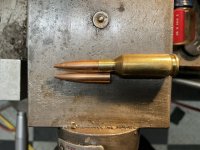After seeing Al's post of his bullet testing, I was wondering what the major disadvantages of steel dies are. I'm wanting to get into making my own bullets for my 30BR and am debating between 7ogive or 10ogive using a 1" jacket.
So what I'm wondering is will a steel die make as good of a bullet as a carbide? How well would they last for someone who is only making their own bullets. I only shoot local club matches and most are shooting 115 Bergers with 2 shooting BiBs which are hard to get here in Canada.
Is the extra cost of the carbide worth it for someone who will only make less than probably 5000 a year?
So what I'm wondering is will a steel die make as good of a bullet as a carbide? How well would they last for someone who is only making their own bullets. I only shoot local club matches and most are shooting 115 Bergers with 2 shooting BiBs which are hard to get here in Canada.
Is the extra cost of the carbide worth it for someone who will only make less than probably 5000 a year?


